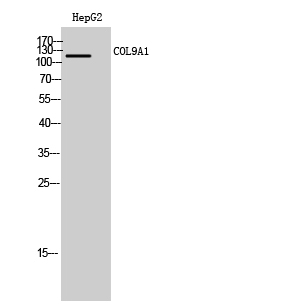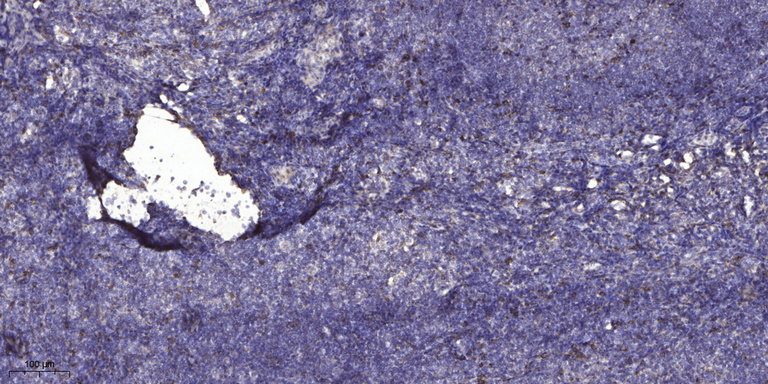COL9A1 Polyclonal Antibody
- Catalog No.:YT1038
- Applications:WB;IHC;IF;ELISA
- Reactivity:Human;Mouse
- Target:
- COL9A1
- Fields:
- >>PI3K-Akt signaling pathway;>>Focal adhesion;>>ECM-receptor interaction;>>Protein digestion and absorption;>>Human papillomavirus infection
- Gene Name:
- COL9A1
- Protein Name:
- Collagen alpha-1(IX) chain
- Human Gene Id:
- 1297
- Human Swiss Prot No:
- P20849
- Mouse Gene Id:
- 12839
- Mouse Swiss Prot No:
- Q05722
- Immunogen:
- Synthesized peptide derived from COL9A1 . at AA range: 390-470
- Specificity:
- COL9A1 Polyclonal Antibody detects endogenous levels of COL9A1 protein.
- Formulation:
- Liquid in PBS containing 50% glycerol, 0.5% BSA and 0.02% sodium azide.
- Source:
- Polyclonal, Rabbit,IgG
- Dilution:
- WB 1:500 - 1:2000. IHC 1:100 - 1:300. ELISA: 1:5000.. IF 1:50-200
- Purification:
- The antibody was affinity-purified from rabbit antiserum by affinity-chromatography using epitope-specific immunogen.
- Concentration:
- 1 mg/ml
- Storage Stability:
- -15°C to -25°C/1 year(Do not lower than -25°C)
- Other Name:
- COL9A1;Collagen alpha-1(IX) chain
- Observed Band(KD):
- 120kD
- Background:
- This gene encodes one of the three alpha chains of type IX collagen, which is a minor (5-20%) collagen component of hyaline cartilage. Type IX collagen is usually found in tissues containing type II collagen, a fibrillar collagen. Studies in knockout mice have shown that synthesis of the alpha 1 chain is essential for assembly of type IX collagen molecules, a heterotrimeric molecule, and that lack of type IX collagen is associated with early onset osteoarthritis. Mutations in this gene are associated with osteoarthritis in humans, with multiple epiphyseal dysplasia, 6, a form of chondrodysplasia, and with Stickler syndrome, a disease characterized by ophthalmic, orofacial, articular, and auditory defects. Two transcript variants that encode different isoforms have been identified for this gene. [provided by RefSeq, Jul 2008],
- Function:
- alternative products:Additional isoforms seem to exist,disease:Defects in COL9A1 are a cause of COL9A1-related multiple epiphyseal dysplasia (COL9A1-MED) [MIM:120210].,disease:Defects in COL9A1 are the cause of Stickler syndrome autosomal recessive COL9A1-related (COL9A1ARSTL) [MIM:120210]. COL9A1ARSTL is an autosomal recessive form of Stickler syndrome, an inherited disorder that associates ocular signs with more or less complete forms of Pierre Robin sequence, bone disorders and sensorineural deafness. Ocular disorders may include juvenile cataract, myopia, strabismus, vitreoretinal or chorioretinal degeneration, retinal detachment, and chronic uveitis. Robin sequence includes an opening in the roof of the mouth (a cleft palate), a large tongue (macroglossia), and a small lower jaw (micrognathia). Bones are affected by slight platyspondylisis and large, often defective epiphyses. Juven
- Subcellular Location:
- Secreted, extracellular space, extracellular matrix .
- Expression:
- Brain,Mammary gland,
- June 19-2018
- WESTERN IMMUNOBLOTTING PROTOCOL
- June 19-2018
- IMMUNOHISTOCHEMISTRY-PARAFFIN PROTOCOL
- June 19-2018
- IMMUNOFLUORESCENCE PROTOCOL
- September 08-2020
- FLOW-CYTOMEYRT-PROTOCOL
- May 20-2022
- Cell-Based ELISA│解您多样本WB检测之困扰
- July 13-2018
- CELL-BASED-ELISA-PROTOCOL-FOR-ACETYL-PROTEIN
- July 13-2018
- CELL-BASED-ELISA-PROTOCOL-FOR-PHOSPHO-PROTEIN
- July 13-2018
- Antibody-FAQs
- Products Images

- Western Blot analysis of HepG2 cells using COL9A1 Polyclonal Antibody

- Immunohistochemical analysis of paraffin-embedded human tonsil. 1, Antibody was diluted at 1:200(4° overnight). 2, Tris-EDTA,pH9.0 was used for antigen retrieval. 3,Secondary antibody was diluted at 1:200(room temperature, 30min).



